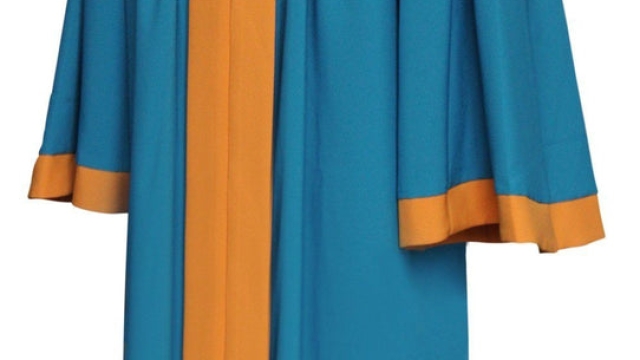
For centuries, choirs have captivated audiences and inspired worshippers with their harmonious voices and soul-stirring melodies. While their angelic music takes center stage, their attire plays a supporting role in creating a captivating visual experience. Enter the enchanting world of choir robes, where tradition, symbolism, and elegance converge to elevate the choral experience to new heights.
When one thinks of a choir, an image of individuals seated or standing in unison, wearing striking robes, often comes to mind. These robes are more than mere garments; they embody a rich history that traces back to medieval times. A choir robe’s design, color, and fabric are carefully chosen to complement the ambiance of the performance, convey a sense of unity and purpose, and steep the choir in a timeless beauty that transcends cultural boundaries.
The significance of choir robes within a religious context is profound. Just as a congregation dons their Sunday best to honor a higher power, choir members outfit themselves in robes that signify their commitment to sacred music. Each robe serves as a visual testament to the choir’s dedication, humility, and reverence for their faith. Indeed, these flowing garments are not only aesthetically pleasing but also carry deep spiritual meaning, enhancing the choir’s ability to connect with both their congregation and the divine.
As we delve into the enchanting world of choir robes, we will uncover the origins and evolution of these mesmerizing garments, explore the intricate symbolism woven into their designs, and gain a deeper appreciation for the role they play in crafting a harmonious and captivating choral performance. Join us as we embark on a journey into the heart of choral music, where beauty and harmony intertwine to uplift souls and celebrate the power of unity.
History of Choir Robes
Choir robes have a rich and fascinating history that spans centuries. These distinctive garments have been a symbol of tradition and unity within the choral community. Throughout the years, choir robes have evolved in style and significance, reflecting the changing times and cultural contexts in which they were worn.
The origins of choir robes can be traced back to ancient religious practices. Early Christian choirs in the Middle Ages often wore simple garments known as "albs" or "cassocks," which were essentially long robes that covered the entire body. These garments not only provided a sense of unity among singers but also served as a way to distinguish them from the congregation during worship services.
As time went on, choir robes became more elaborate and ornate. During the Renaissance period, choirs began to wear robes made of luxurious fabrics such as velvet and silk. These robes were often adorned with intricate embroidery and decorative elements, symbolizing the high status of the choir and adding a touch of elegance to their performances.
In the 19th and early 20th centuries, choir robes took on a more uniformed appearance. The influence of academic dress became prominent, with choirs adopting similar styles of robes to those worn by scholars and graduates. This shift emphasized the formal and prestigious nature of choral singing, aligning it with the esteemed traditions of academia.
Over time, choir robes have continued to evolve, adapting to contemporary styles and preferences. While some choirs still favor traditional designs, many are now exploring more modern and diverse options. From vibrant colors to unique patterns, choir robes today reflect the individuality and creativity of the ensembles they represent.
In conclusion, the history of choir robes is a testament to the enduring significance of choral music and its role in various cultural and religious traditions. These robes have not only provided a sense of identity and unity among singers but also served as visual markers of the choir’s esteemed position within their communities.
Symbolism in Choir Robes
Choir Robes For Kids
Choir robes hold immense symbolism within the realm of choral music. These garments, worn by singers during performances, not only serve a functional purpose but also convey a deep sense of tradition and unity.
The color of choir robes plays a significant role in expressing the mood and atmosphere of a musical piece. Often, the choice of color is associated with the liturgical calendar, with white representing purity and celebration, black signifying solemnity and mourning, and red symbolizing sacrifice and passion. The hues worn by choirs can greatly enhance the overall aesthetic and emotional impact of a performance.
In addition to color, the design and embellishments on choir robes also hold symbolic meaning. Details such as crosses, doves, or musical notes intricately woven or embroidered onto the fabric can reflect the spiritual nature of choral music. These symbols not only pay homage to the religious origins of choral compositions but also serve as a reminder of the choir’s commitment to faithfully communicate the messages conveyed through their voices.
Moreover, the act of wearing choir robes fosters a sense of unity among singers. By dressing uniformly, choir members become part of a collective entity, transcending their individual identities. This unity extends beyond physical appearance and creates an atmosphere of teamwork and collaboration, enhancing the harmonious experience both for the performers and the audience.
In conclusion, choir robes are not merely garments worn during choral performances; they embody the essence of choral music through symbolism, color, and design. They represent the shared dedication of a group of individuals and enhance the overall aesthetic and spiritual impact of vocal performances.
Evolution of Choir Robe Styles
Over the years, choir robe styles have evolved significantly to reflect the changing trends and preferences of choir communities worldwide. These elegant garments, often made of high-quality fabrics, have undergone various transformations, showcasing the rich history and cultural significance of choral music. Let’s delve into the captivating journey of choir robes, from their humble beginnings to their modern-day allure.
- Traditional Elegance
In the early days, choir robes exuded an air of traditional elegance. Crafted with meticulous attention to detail, these robes featured flowing silhouettes, intricate embellishments, and regal colors. Often made from luxurious fabrics like silk or velvet, these robes projected a sense of grandeur and reverence during performances. They were designed to create a visually striking ensemble, perfectly accentuating the harmony and unity of the choir.
- Simplified Sophistication
As time progressed, choir robe styles transitioned towards a more simplified and sophisticated look. The focus shifted from elaborate detailing to clean lines and minimalist designs. This evolution aimed to emphasize the choral performance itself, allowing the voices of the singers to take center stage. Robes became more streamlined, enhancing the choir’s collective presence while still maintaining an aura of elegance and formality.
- Contemporary Versatility
In recent years, choir robe styles have adapted to reflect the contemporary aesthetics and preferences of choirs. Designers have embraced versatility, offering a range of options to cater to different musical genres, occasions, and individual expressions. Choir robes now come in various cuts, lengths, and colors, allowing choirs to showcase their unique style and creativity. Whether it’s a pop choir sporting vibrant robes, or a classical ensemble donning sleek and refined attire, modern choir robe styles celebrate the diversity within the choral community.

